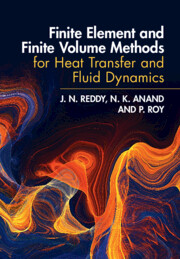Refine search
Actions for selected content:
36807 results in Cambridge Textbooks

Programming Languages
- Build, Prove, and Compare
-
- Published online:
- 27 January 2023
- Print publication:
- 27 October 2022
-
- Textbook
- Export citation

Finite Element and Finite Volume Methods for Heat Transfer and Fluid Dynamics
-
- Published online:
- 27 January 2023
- Print publication:
- 27 October 2022
-
- Textbook
- Export citation
Introduction
- from Part One - Preliminaries
-
- Book:
- Camino al español
- Published online:
- 22 February 2023
- Print publication:
- 26 January 2023, pp 3-6
-
- Chapter
- Export citation
Conclusion
-
- Book:
- The People's Dictatorship
- Published online:
- 20 January 2023
- Print publication:
- 26 January 2023, pp 241-244
-
- Chapter
- Export citation
Unidad 8 - ¿Qué van a tomar?
- from Part Two - The Units
-
- Book:
- Camino al español
- Published online:
- 22 February 2023
- Print publication:
- 26 January 2023, pp 190-210
-
- Chapter
- Export citation
8 - The Nazi Empire
-
- Book:
- The People's Dictatorship
- Published online:
- 20 January 2023
- Print publication:
- 26 January 2023, pp 171-190
-
- Chapter
- Export citation
Transcripts
- from Part Two - The Units
-
- Book:
- Camino al español
- Published online:
- 22 February 2023
- Print publication:
- 26 January 2023, pp 554-575
-
- Chapter
- Export citation
Introduction to Pronunciation, Word Stress and Intonation
- from Part Two - The Units
-
- Book:
- Camino al español
- Published online:
- 22 February 2023
- Print publication:
- 26 January 2023, pp 576-579
-
- Chapter
- Export citation
Spanish Verb Tables
- from Part Three - Reference Tools and Study Aids
-
- Book:
- Camino al español
- Published online:
- 22 February 2023
- Print publication:
- 26 January 2023, pp 594-604
-
- Chapter
- Export citation
Unidad 7 - De viaje
- from Part Two - The Units
-
- Book:
- Camino al español
- Published online:
- 22 February 2023
- Print publication:
- 26 January 2023, pp 165-189
-
- Chapter
- Export citation
Contents
-
- Book:
- Camino al español
- Published online:
- 22 February 2023
- Print publication:
- 26 January 2023, pp v-vi
-
- Chapter
- Export citation
Figure Credits
-
- Book:
- Camino al español
- Published online:
- 22 February 2023
- Print publication:
- 26 January 2023, pp viii-viii
-
- Chapter
- Export citation
Dedication
-
- Book:
- Second Language Acquisition
- Published online:
- 03 February 2023
- Print publication:
- 26 January 2023, pp v-vi
-
- Chapter
- Export citation
6 - Policing the Boundaries of the People’s Community
-
- Book:
- The People's Dictatorship
- Published online:
- 20 January 2023
- Print publication:
- 26 January 2023, pp 122-148
-
- Chapter
- Export citation
Unidad 20 - Si fuera millonario …
- from Part Two - The Units
-
- Book:
- Camino al español
- Published online:
- 22 February 2023
- Print publication:
- 26 January 2023, pp 485-511
-
- Chapter
- Export citation
Unidad 11 - Cuando era pequeña
- from Part Two - The Units
-
- Book:
- Camino al español
- Published online:
- 22 February 2023
- Print publication:
- 26 January 2023, pp 255-277
-
- Chapter
- Export citation
Brief Contents
-
- Book:
- Second Language Acquisition
- Published online:
- 03 February 2023
- Print publication:
- 26 January 2023, pp vii-viii
-
- Chapter
- Export citation
Part Three - Reference Tools and Study Aids
-
- Book:
- Camino al español
- Published online:
- 22 February 2023
- Print publication:
- 26 January 2023, pp 583-584
-
- Chapter
- Export citation
Unidad 19 - ¿Qué harías?
- from Part Two - The Units
-
- Book:
- Camino al español
- Published online:
- 22 February 2023
- Print publication:
- 26 January 2023, pp 455-484
-
- Chapter
- Export citation
Part Three - Reference Tools and Study Aids
-
- Book:
- Camino al español
- Published online:
- 22 February 2023
- Print publication:
- 26 January 2023, pp 583-584
-
- Chapter
- Export citation
